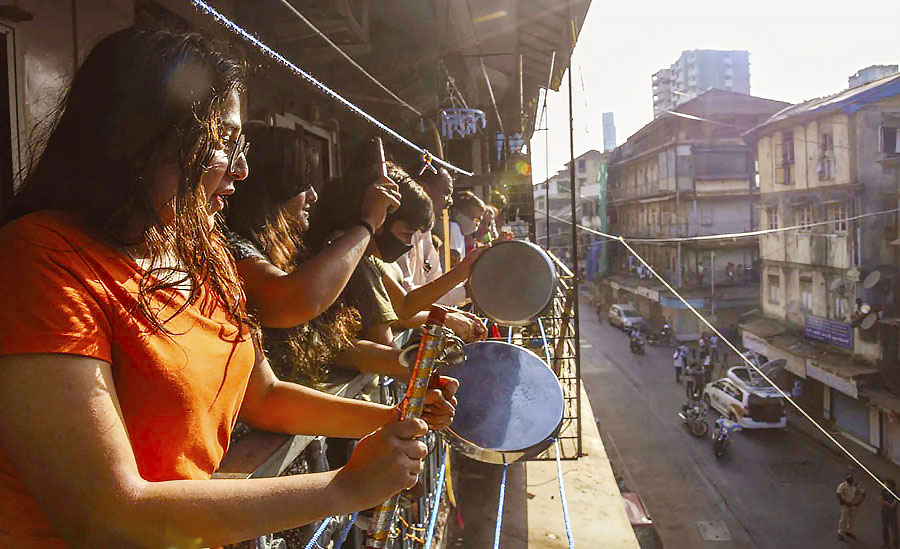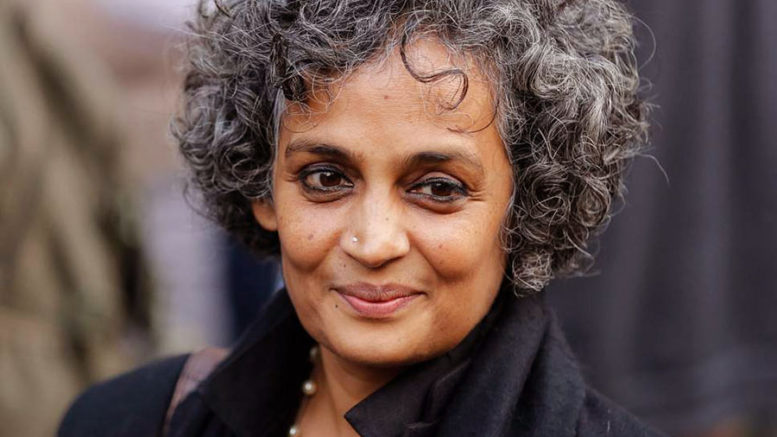Acclaimed Indian novelist Arundhati Roy, observes how Covid-19 has affected her country and the world, and the inadequate response, as the political madarins bcarried on with its own political agenda (Financial Times 3 October 2020). She hints at what India and the world should do next.
Who can use the term “gone viral” now without shuddering a little? Who can look at anything any more — a door handle, a cardboard carton, a bag of vegetables — without imagining it swarming with those unseeable, undead, unliving blobs dotted with suction pads waiting to fasten themselves on to our lungs?
Who can think of kissing a stranger, jumping on to a bus or sending their child to school without feeling real fear?
Who can think of ordinary pleasure and not assess its risk?
Who among us is not a quack epidemiologist, virologist, statistician and prophet?
Which scientist or doctor is not secretly praying for a miracle? Which priest is not — secretly, at least — submitting to science?
And even while the virus proliferates, who could not be thrilled by the swell of birdsong in cities, peacocks dancing at traffic crossings and the silence in the skies?
The number of cases worldwide this week crept over a million. More than 50,000 people have died already. Projections suggest that number will swell to hundreds of thousands, perhaps more. The virus has moved freely along the pathways of trade and international capital, and the terrible illness it has brought in its wake has locked humans down in their countries, their cities and their homes.
But unlike the flow of capital, this virus seeks proliferation, not profit, and has, therefore, inadvertently, to some extent, reversed the direction of the flow. It has mocked immigration controls, biometrics, digital surveillance and every other kind of data analytics, and struck hardest — thus far — in the richest, most powerful nations of the world, bringing the engine of capitalism to a juddering halt.
Temporarily perhaps, but at least long enough for us to examine its parts, make an assessment and decide whether we want to help fix it, or look for a better engine.
The mandarins who are managing this pandemic are fond of speaking of war. They don’t even use war as a metaphor, they use it literally. But if it really were a war, then who would be better prepared than the US?
If it were not masks and gloves that its frontline soldiers needed, but guns, smart bombs, bunker busters, submarines, fighter jets and nuclear bombs, would there be a shortage?
Donald Trump speaks about the coronavirus at a White House briefing on April 1, as the number of US cases topped 206,000.
Donald Trump speaks about the coronavirus at a White House briefing on April 1, as the number of US cases topped 200,000 © AP/Alex Brandon Narendra Modi with the US president and his wife Melania at a packed rally in Ahmedabad on February 24 — part of a lavish official visit Narendra Modi with the US president and his wife Melania at a packed rally in Ahmedabad on February 24 — part of a lavish official visit.

Night after night, from halfway across the world, some of us watch the New York governor’s press briefings with a fascination that is hard to explain. We follow the statistics, and hear the stories of overwhelmed hospitals in the US, of underpaid, overworked nurses having to make masks out of garbage bin liners and old raincoats, risking everything to bring succour to the sick. About states being forced to bid against each other for ventilators, about doctors’ dilemmas over which patient should get one and which left to die. And we think to ourselves, “My God! This is America!”
The tragedy is immediate, real, epic and unfolding before our eyes. But it isn’t new. It is the wreckage of a train that has been careening down the track for years. Who doesn’t remember the videos of “patient dumping” — sick people, still in their hospital gowns, butt naked, being surreptitiously dumped on street corners?
Hospital doors have too often been closed to the less fortunate citizens of the US. It hasn’t mattered how sick they’ve been, or how much they’ve suffered. At least not until now — because now, in the era of the virus, a poor person’s sickness can affect a wealthy society’s health.
And yet, even now, Bernie Sanders, the senator who has relentlessly campaigned for healthcare for all, is considered an outlier in his bid for the White House, even by his own party.
The tragedy is the wreckage of a train that has been careening down the track for years
And what of my country, my poor-rich country, India, suspended somewhere between feudalism and religious fundamentalism, caste and capitalism, ruled by far-right Hindu nationalists?
In December, while China was fighting the outbreak of the virus in Wuhan, the government of India was dealing with a mass uprising by hundreds of thousands of its citizens protesting against the brazenly discriminatory anti-Muslim citizenship law it had just passed in parliament.
The first case of Covid-19 was reported in India on January 30, only days after the honourable chief guest of our Republic Day Parade, Amazon forest-eater and Covid-denier Jair Bolsonaro, had left Delhi. But there was too much to do in February for the virus to be accommodated in the ruling party’s timetable.
There was the official visit of President Donald Trump scheduled for the last week of the month. He had been lured by the promise of an audience of 1m people in a sports stadium in the state of Gujarat. All that took money, and a great deal of time.
Then there were the Delhi Assembly elections that the Bharatiya Janata Party was slated to lose unless it upped its game, which it did, unleashing a vicious, no-holds-barred Hindu nationalist campaign, replete with threats of physical violence and the shooting of “traitors”. It lost anyway. So then there was punishment to be meted out to Delhi’s Muslims, who were blamed for the humiliation.
Armed mobs of Hindu vigilantes, backed by the police, attacked Muslims in the working-class neighbourhoods of north-east Delhi. Houses, shops, mosques and schools were burnt. Muslims who had been expecting the attack fought back. More than 50 people, Muslims and some Hindus, were killed. Thousands moved into refugee camps in local graveyards.
Mutilated bodies were still being pulled out of the network of filthy, stinking drains when government officials had their first meeting about Covid-19 and most Indians first began to hear about the existence of something called hand sanitiser.
In response to the call of Prime Minister Narenda Modi, a group of women come out onto their apartment’s balcony clapping and banging dishes in a display of thanks and support for the emergency services on the frontline fighting the coronavirus outbreak.

Women bang pots and pans to show their support for the emergency services dealing with the coronavirus outbreak © Atul Loke/Panos Pictures March was busy too.
The first two weeks were devoted to toppling the Congress government in the central Indian state of Madhya Pradesh and installing a BJP government in its place.
On March 11 the World Health Organization declared that Covid-19 was a pandemic. Two days later, on March 13, the health ministry said that corona “is not a health emergency”.
Finally, on March 19, the Indian prime minister addressed the nation. He hadn’t done much homework. He borrowed the playbook from France and Italy. He told us of the need for “social distancing” (easy to understand for a society so steeped in the practice of caste) and called for a day of “people’s curfew” on March 22.
He said nothing about what his government was going to do in the crisis, but he asked people to come out on their balconies, and ring bells and bang their pots and pans to salute health workers.
He didn’t mention that, until that very moment, India had been exporting protective gear and respiratory equipment, instead of keeping it for Indian health workers and hospitals. Not surprisingly, Narendra Modi’s request was met with great enthusiasm. There were pot-banging marches, community dances and processions. Not much social distancing.
In the days that followed, men jumped into barrels of sacred cow dung, and BJP supporters threw cow-urine drinking parties. Not to be outdone, many Muslim organisations declared that the Almighty was the answer to the virus and called for the faithful to gather in mosques in numbers.
On March 24, at 8pm, Modi appeared on TV again to announce that, from midnight onwards, all of India would be under lockdown. Markets would be closed. All transport, public as well as private, would be disallowed.
He said he was taking this decision not just as a prime minister, but as our family elder. Who else can decide, without consulting the state governments that would have to deal with the fallout of this decision, that a nation of 1.38bn people should be locked down with zero preparation and with four hours’ notice? His methods definitely give the impression that India’s prime minister thinks of citizens as a hostile force that needs to be ambushed, taken by surprise, but never trusted.
Locked down we were. Many health professionals and epidemiologists have applauded this move. Perhaps they are right in theory. But surely none of them can support the calamitous lack of planning or preparedness that turned the world’s biggest, most punitive lockdown into the exact opposite of what it was meant to achieve. The man who loves spectacles created the mother of all spectacles.


Be the first to comment on "Arundhati Roy says ‘The pandemic is a portal’"